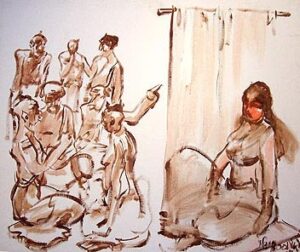
Post-independence Kerala was a place buzzing with energy, standing on the precipice of great transformation. Finally free from colonial rule and now under democratic governance, waves of change swept over the civilization. Reformations heralded by the Kerala renaissance leaders backed by laws, the euphoria of holding agency of oneself in the new age, the guarantee of rights and so on promised a great future. This sense of liberty and jubilation inspired the creative minds of the people – be it poets, novelists, artists, filmmakers. Stories of the altering landscape of Kerala society became a theme in many works of art.
One such facet that captured the public interest was the emancipation of women from prior constraints. There weren’t great ‘breaking of the glass ceiling’ moments and women’s struggles on various fronts continued for the years to come. But women were stepping out of their houses and getting education, got involved in fair pay debates and political process, and occupied work spaces. The image of a woman being a docile creature at home and/or a diligent workhorse was getting corrected. One such person that captured the attention of Malayali populace was that of a Namboothiri woman named Kuriyedathu Thatri. Her life was a mirror held up against the misogynist and patriarchal society which showed its ugly face and ways.
Thatri was born into a Namboothiri family in 1885. This was a time when strict caste and gender roles were prevalent in the Kerala society. Namboothiris would fall under the Brahmin category and occupy the top position in the caste hierarchy. While being the only group who could be priests in temples, thus possessing supreme religious authority, they also held immense financial and political power in the erstwhile Kerala society. Even though this superiority extended to the women of Namboothiri households, their lives were extremely restricted. Namboothiri women could only marry within the caste while only the eldest son in the family was allowed to do so. Since marrying off girl children was very important, this had led to situations where girls as young as 8 or 10 were married off to men who were 60 or above.
Thatri also had to face the same plight. She was married to Raman Namboothiri who was in his early 60s when she was around 11-13. And this was after facing various instances of sexual assaults at a young age from her family members. Her life after marriage was not any good either. After receiving further abuse from her husband and other male acquaintances, their marriage fell apart. Thatri had a series of sexual relations with other men after this. Some historians state that she considered those acts as an expression of her rebellion. In a time when both sexuality and women’s virtue were considered absolutely sacred and private, her wanton ways were a sign of protest. Others claim that as an estranged wife with next to no agency, she was pushed into prostitution. She had affairs with over 50 men, many of whom were prominent members of the society like priests, renowned artists and so on. And when someone raised a complaint against her to the elders of the community, it was decided that a smarthavicharam will be conducted.

Smarthavicharam was essentially a committee of the older Namboothiri men who presided over cases related to adultery. If the accused were found guilty, they would be excommunicated. As it would have been very difficult to live on their own, women usually did not admit to their mistakes. But Thatri changed the routine and during her trial she admitted to have slept with multiple men. She firmly argued that if she was to be deemed culpable for immoral acts, her partners should also be condemned. In a pretty bold move, she took the names of the 64 men who she had slept with. It is said that when questioned about her claims, she started citing birthmarks and other private identifiers on the bodies of these men as proof of her liaisons with them. And in one of the anecdotes related to this trail, it is alleged that she was about to name a 65th person but the King put a stop to it. Many say that it would have been somebody close to the king or even the king himself.
Thatri was excommunicated from her family after the trial and the accused men were thoroughly discredited in the society, some even had to flee from their homes. There isn’t any concrete proof of what happened to Thatri after she left her house. But her trial is believed to have played an important part in many changes that happened in the Namboothiri community. Her unwavering stance on holding on to her truth was an eye opener to the community members as it showed the repercussions of outdated rules and customs on private lives. Just a single woman’s act of standing up for herself sent shockwaves through the well laid foundation of patriarchal self-righteousness. It was a much needed epiphany to realize that the world is changing and women are not going to be passive participants of their lives being made into games the men control.

